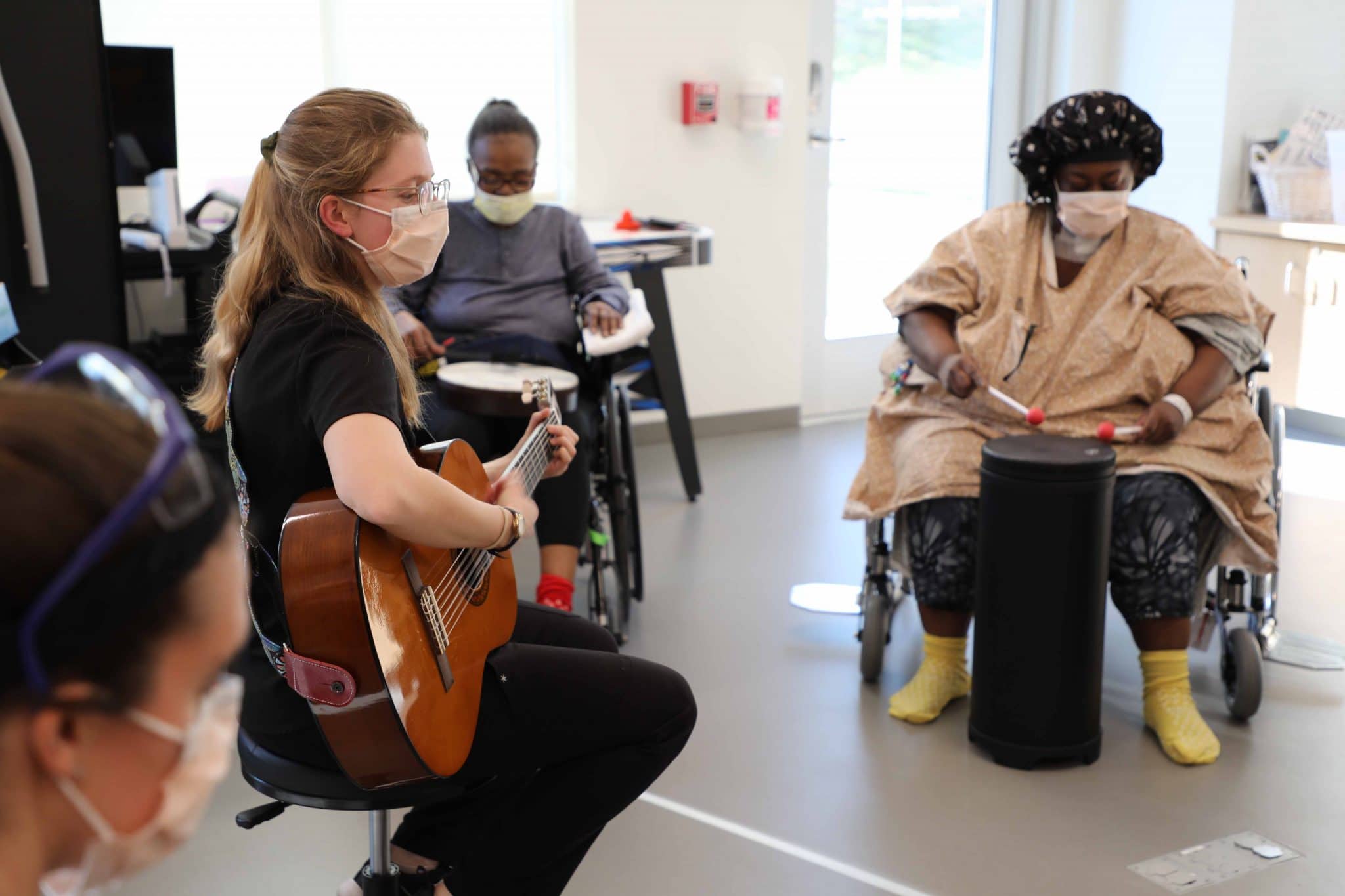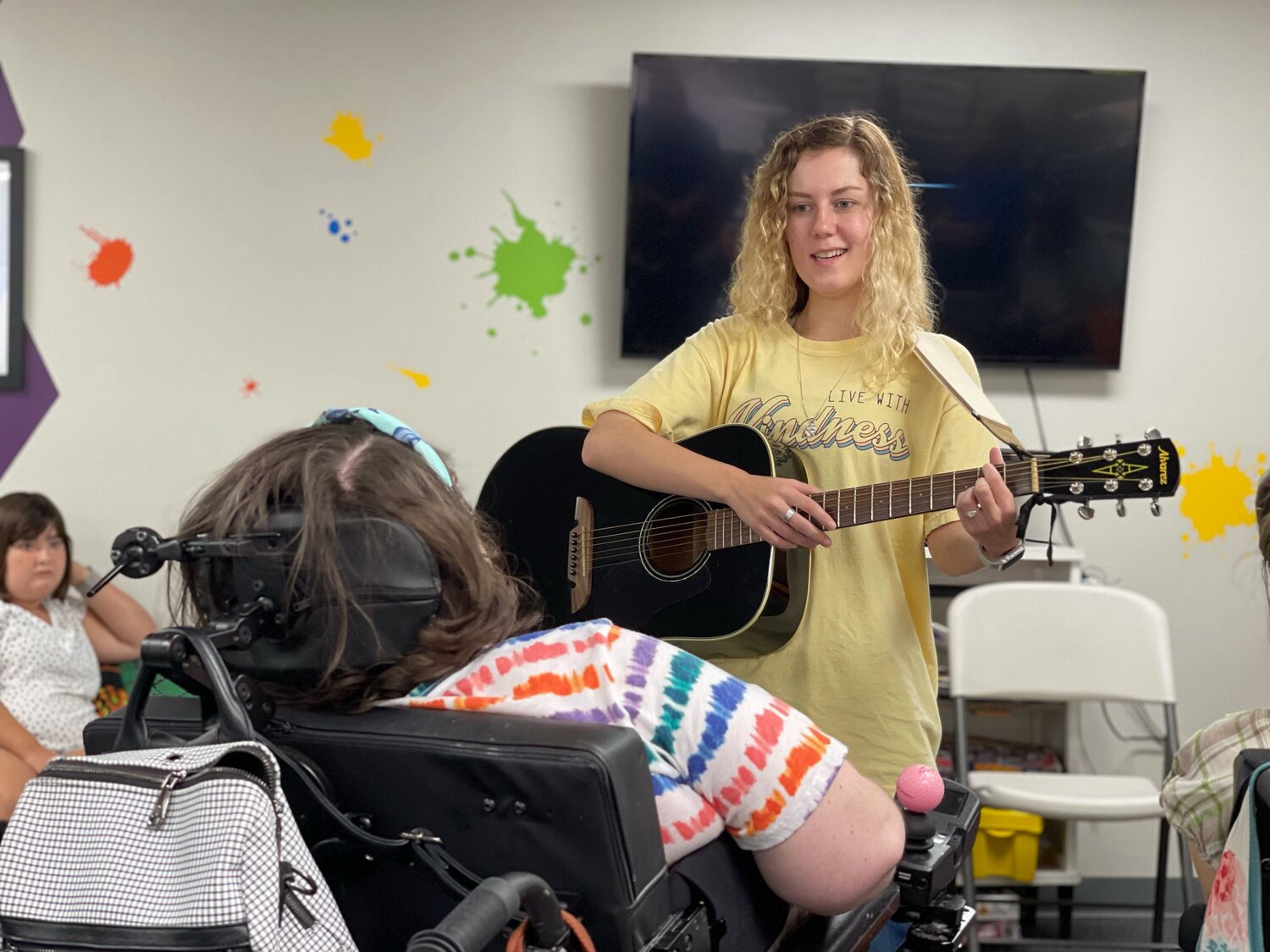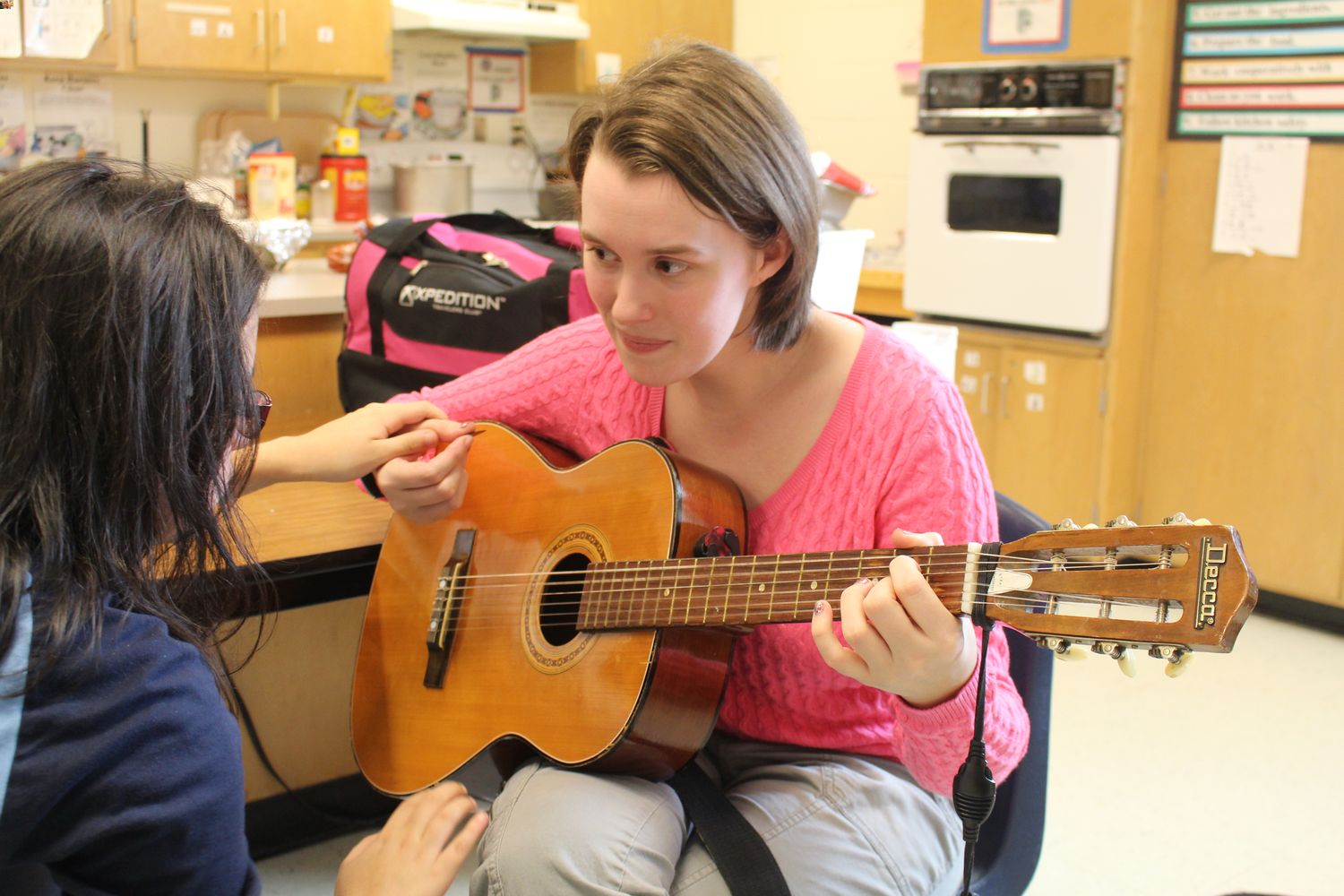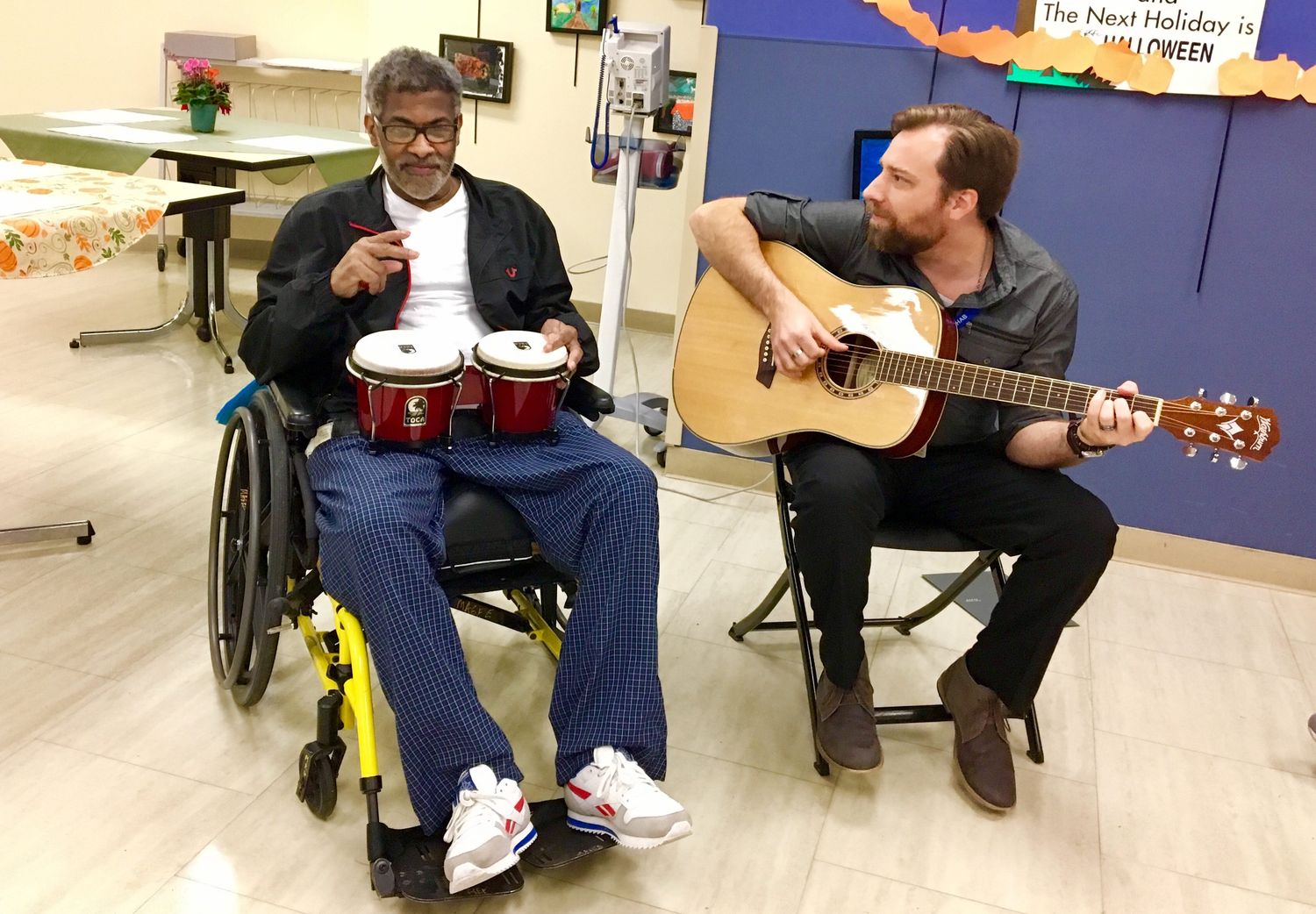Home>Events & Info>Music Therapy>What Is Music Therapy For


Music Therapy
What Is Music Therapy For
Modified: February 2, 2024
Discover the powerful effects of music therapy and how it can promote emotional, mental, and physical well-being. Learn more about the benefits and applications of music therapy today.
(Many of the links in this article redirect to a specific reviewed product. Your purchase of these products through affiliate links helps to generate commission for AudioLover.com, at no extra cost. Learn more)
Table of Contents
Introduction
Welcome to the world of music therapy! In this article, we will explore the fascinating field of music therapy and its numerous benefits. Music therapy is an evidence-based practice that harnesses the power of music to improve physical, emotional, and cognitive well-being. Whether used as a standalone therapy or as a complementary approach, music therapy has proven to be remarkably effective in various settings.
Music has always held a special place in human culture. It has the ability to evoke emotions, trigger memories, and create connections. Music therapy takes this innate power of music and applies it in a therapeutic context, guided by trained music therapists who have a deep understanding of both music and therapy.
From ancient civilizations to modern times, music has been recognized for its healing properties. Many cultures throughout history have used music as a means of promoting health and well-being. However, music therapy as a formal profession gained recognition in the 20th century.
In the following sections, we will delve into the history of music therapy, explore the role of a music therapist, and examine the diverse benefits of this unique approach. We will also discuss various music therapy techniques, applications in different settings, and the current research and evidence supporting its effectiveness.
It’s important to note that music therapy is not limited to a specific population or age group. It can be utilized with individuals of all ages, including children, adolescents, adults, and older adults. Music therapy can also be tailored to address a wide range of needs, such as developmental disabilities, mental health conditions, chronic pain, neurological disorders, and more.
Whether you have a personal interest in music therapy or are exploring therapeutic options for yourself or a loved one, this article aims to provide a comprehensive overview of the field. So, let’s embark on this musical journey and discover the transformative power of music therapy!
Defining Music Therapy
Music therapy can be defined as the clinical and evidence-based use of music interventions to achieve individualized goals within a therapeutic relationship. It is a specialized field that combines the inherent properties of music with therapeutic principles to address physical, emotional, cognitive, and social needs of individuals.
Music therapists are trained professionals who integrate musical elements such as rhythm, melody, harmony, and lyrics into therapeutic interventions. These interventions are designed to facilitate non-musical therapeutic goals, such as improving communication skills, increasing self-expression, reducing anxiety, enhancing motor coordination, promoting relaxation, and fostering emotional well-being.
Unlike simply listening to music for enjoyment, music therapy involves active participation and engagement. The therapist uses various music-based activities, including playing instruments, singing, songwriting, movement to music, and listening exercises, to elicit specific responses and achieve therapeutic outcomes.
Music therapy can be conducted in both individual and group settings, depending on the needs of the client. The therapist assesses the client’s abilities, preferences, and goals to develop a personalized treatment plan. Sessions can take place in hospitals, schools, rehabilitation centers, nursing homes, mental health facilities, and private practice settings.
The effectiveness of music therapy is rooted in the unique properties of music. Music has the power to stimulate multiple areas of the brain simultaneously, evoking emotional responses, enhancing memory recall, and promoting relaxation. It can bypass language barriers and provide a means of communication for individuals who struggle with verbal expression.
Music therapy also offers a non-threatening and enjoyable medium for therapeutic work. It creates a safe and supportive space where individuals can explore and express their emotions, develop coping strategies, and build self-esteem. By harnessing the elements of music, music therapists can facilitate meaningful and transformative experiences for their clients.
It’s important to note that music therapy is a distinct profession, requiring specialized education and training. Music therapists undergo rigorous coursework, clinical training, and supervised internship experiences to develop the necessary skills and knowledge to practice ethically and effectively.
In the next section, we will delve further into the rich history of music therapy and explore how it has evolved to become an essential component of modern healthcare.
History of Music Therapy
Music therapy has a rich and diverse history that spans across cultures and centuries. The therapeutic use of music can be traced back to ancient civilizations, where music was recognized for its healing properties.
In ancient Greece, for example, music was used to promote physical and emotional well-being. The Greek philosopher Aristotle believed that music could have a direct effect on a person’s character and emotions. Early Greek physicians also utilized music as a form of therapy, incorporating it into their treatments for various ailments.
Music’s therapeutic benefits were also acknowledged in ancient Egypt, where temples dedicated to the god of music, Hathor, were used as healing sanctuaries. These temples offered music and dance rituals as part of the healing process.
The more structured profession of music therapy began to emerge in the 20th century. The field gained recognition during World War I and World War II, when musicians played for injured soldiers in hospitals. The positive outcomes observed during these wartime initiatives sparked interest in the potential therapeutic value of music.
In the 1940s, music therapy became more formalized, with the establishment of the National Association for Music Therapy (NAMT) in the United States. This organization played a pivotal role in setting standards and promoting the field. In 1998, NAMT merged with another music therapy organization to form the American Music Therapy Association (AMTA), which is still active today.
Over the years, music therapy has evolved and expanded to address a wide range of populations and needs. The development of evidence-based practices and research studies has further solidified music therapy as a legitimate and effective therapeutic intervention.
Today, music therapy is utilized in a variety of settings, including healthcare facilities, schools, assisted living centers, mental health clinics, and private practice. Music therapists work with diverse populations, including children with developmental disabilities, individuals with Alzheimer’s disease, patients undergoing medical procedures, individuals with mental health conditions, and people dealing with chronic pain or trauma.
As we continue to discover more about the profound impact of music on our well-being, music therapy is gaining recognition and acceptance as a valuable and integrative approach to healthcare. Its historical roots provide a rich foundation for its practice, while ongoing research and innovation continue to shape and expand the field.
Next, we will explore the invaluable role of a music therapist and how they facilitate meaningful therapeutic experiences through music.
Role of a Music Therapist
Music therapists play a vital role in the effective implementation of music therapy. They are highly trained professionals who possess an in-depth understanding of both music and therapy, allowing them to create personalized interventions that address the unique needs of their clients.
Music therapists undergo extensive education and clinical training to acquire the necessary knowledge and skills. They typically hold a bachelor’s or master’s degree in music therapy, which includes coursework in psychology, music theory, improvisation, research methods, and clinical practice. Additionally, they complete supervised internships to gain practical experience in working with a wide range of populations and settings.
The role of a music therapist is multifaceted, encompassing various responsibilities. Here are some key aspects of their role:
Assessment: Music therapists conduct thorough assessments to understand their clients’ abilities, needs, and goals. They gather information through interviews, observations, and standardized assessments, if applicable, to develop a tailored treatment plan.
Treatment Planning: Based on the assessment findings, music therapists create individualized treatment plans that outline specific musical interventions and goals. They consider the preferences and strengths of their clients to ensure the therapeutic process is engaging and meaningful.
Music-Based Interventions: Music therapists utilize a wide range of techniques and activities to address therapeutic goals. These may include listening to music, playing instruments, engaging in singing or songwriting, improvisation, movement to music, and guided imagery exercises. They carefully select and adapt interventions to best support the progress and well-being of their clients.
Therapeutic Relationship: Building a strong therapeutic relationship is a cornerstone of music therapy. Music therapists provide a safe and supportive environment where clients feel comfortable expressing themselves and exploring their emotions. They establish trust and rapport, fostering a collaborative partnership with their clients.
Evaluation and Documentation: Throughout the therapy process, music therapists continually evaluate the progress of their clients and adjust treatment strategies as needed. They document observations, changes, and outcomes to ensure accountability and maintain a comprehensive record of the therapeutic journey.
Collaboration: Music therapists often collaborate with other healthcare professionals, educators, and family members to ensure a holistic and integrated approach to care. They work as part of a multidisciplinary team, sharing insights and contributing to the larger treatment plan.
Continuing Education: Music therapists commit to lifelong learning and professional growth. They stay updated on new research, interventions, and best practices through continued education, conferences, and workshops. This allows them to provide the most effective and evidence-based care to their clients.
The role of a music therapist is dynamic and adaptable, allowing them to address a wide range of goals and populations. Their expertise in music and therapy enables them to create meaningful and transformative experiences for individuals of all ages and abilities.
In the next section, we will uncover the multitude of benefits that music therapy can provide.
Benefits of Music Therapy
Music therapy offers a plethora of benefits across physical, emotional, cognitive, and social domains. By harnessing the power of music, music therapists facilitate positive changes and improvements in the lives of their clients. Here are some notable benefits of music therapy:
- Emotional Support and Expression: Music has the ability to evoke and express emotions in a profound way. Through music therapy, individuals can explore and process their emotions, gaining a sense of comfort, validation, and release.
- Stress Reduction and Relaxation: Listening to calming music, engaging in rhythmic activities, and participating in guided relaxation exercises can help reduce stress and promote relaxation. Music therapy provides a therapeutic outlet to unwind and find inner calm.
- Improved Communication: Music can act as a bridge for communication, especially for individuals who struggle with verbal expression. Music therapy encourages communication through singing, songwriting, and musical interactions, fostering social connections and self-expression.
- Enhanced Cognitive Abilities: Engaging in music-based activities can stimulate cognitive functioning. Music therapy can improve attention, focus, memory, and problem-solving skills. It can also be beneficial for individuals with neurodegenerative disorders, as music can access preserved neural pathways.
- Motor Skills Development: Playing instruments, engaging in rhythmic movements, and participating in music-based exercises can enhance fine and gross motor skills. Music therapy can be particularly valuable for individuals with physical disabilities or motor impairments.
- Pain Management: Music has been shown to reduce pain perception and improve the overall experience of pain. Music therapy interventions can provide distraction, relaxation, and a sense of control for individuals experiencing acute or chronic pain.
- Emotional Regulation: Music therapy can help individuals regulate their emotions, providing a healthy outlet for emotional expression. It can teach coping strategies, enhance self-awareness, and promote emotional well-being.
- Social Skills Development: Group music therapy sessions can foster social interactions and improve social skills. Collaborative music-making, turn-taking, and sharing musical experiences create opportunities for connection, empathy, and teamwork.
- Self-esteem and Confidence Building: Accomplishing musical goals, receiving positive feedback, and gaining a sense of mastery can boost self-esteem and confidence. Music therapy provides a nurturing environment for individuals to discover and develop their strengths.
- Quality of Life Enhancement: Music therapy can have a transformative impact on overall well-being. It promotes joy, pleasure, and a sense of purpose, enhancing the quality of life for individuals of all ages and abilities.
These benefits are not limited to specific populations; music therapy can be tailored to address the needs of children, adolescents, adults, and older adults with a wide range of conditions and challenges. The power of music transcends language and cultural barriers, making it a universally accessible and impactful therapeutic tool.
In the next section, we will explore some of the music therapy techniques employed by music therapists to achieve these varied benefits.
Music Therapy Techniques
Music therapy employs a variety of techniques and interventions to meet the unique needs and goals of each individual. These techniques utilize the elements of music, such as rhythm, melody, harmony, and lyrics, to elicit specific responses and facilitate therapeutic outcomes. Here are some commonly used music therapy techniques:
- Active Music Making: This technique encourages individuals to actively participate in creating music. It can involve playing instruments, such as drums, guitars, or keyboards, or using their voices to sing or chant. Active music making promotes self-expression, creativity, and engagement in the therapeutic process.
- Music Listening: Listening to carefully selected music can have profound therapeutic effects. Music therapists choose music that matches the individual’s needs and goals, whether it’s calming music for relaxation or upbeat music for motivation. This technique can evoke emotions, trigger memories, and promote a sense of well-being.
- Songwriting and Lyric Analysis: Songwriting allows individuals to express themselves through the creation of original songs. It can be a powerful tool for self-reflection, storytelling, and emotional expression. Lyric analysis involves examining the lyrics of existing songs to explore their personal meanings and connect them to the individual’s experiences and emotions.
- Movement to Music: Movement-based techniques involve using music as a catalyst for physical movement and coordination. Dance, structured movement exercises, and rhythmic activities are incorporated to enhance motor skills, body awareness, and self-expression.
- Improvisation: Improvisation allows individuals to spontaneously create music without predetermined structures or rules. It encourages freedom of expression, creativity, and exploration. Improvisation can be solo or group-based and facilitates communication, emotional release, and problem-solving.
- Musical Games: Music therapists often use games that incorporate musical elements to engage individuals in a fun and interactive way. These games can target specific goals, such as turn-taking, following directions, and social interaction. Musical games promote cognitive skills, listening skills, and socialization.
- Guided Imagery and Music: Guided imagery involves using music to create a specific atmosphere and guide individuals through a visualization or storytelling process. This technique can promote relaxation, creativity, emotional exploration, and personal insight.
- Music-Assisted Relaxation: Relaxation techniques combined with soothing music help individuals achieve a state of deep relaxation and stress reduction. Breathing exercises, progressive muscle relaxation, and mindfulness techniques are commonly used in conjunction with calming music.
- Adaptive Music Lessons: Music therapy can also incorporate adaptive music lessons for individuals who wish to learn to play an instrument. These lessons are tailored to accommodate individual abilities and goals, making music education accessible and enjoyable.
These techniques are applied based on the individual’s preferences, goals, and therapeutic needs. Music therapists are skilled in adapting and modifying interventions to best support the unique capabilities and challenges of each client.
In the following section, we will explore the diverse applications of music therapy in different settings.
Applications of Music Therapy
Music therapy has a wide range of applications and can be utilized in various settings to address diverse needs. Here are some of the key areas where music therapy is commonly applied:
- Healthcare: Music therapy is widely used in healthcare settings, including hospitals, rehabilitation centers, and hospices. It can aid in pain management, promote relaxation, and provide emotional support for patients undergoing medical procedures or dealing with chronic illnesses. Music therapy has also been beneficial for individuals receiving treatment for cancer, cardiovascular conditions, and neurological disorders.
- Special Education: Music therapy plays a significant role in special education classrooms, supporting individuals with developmental disabilities, autism spectrum disorder, and learning difficulties. It helps improve communication, social skills, cognitive abilities, and motor coordination. Music therapists collaborate with educators to integrate music therapy into the curriculum and assist in achieving educational goals.
- Mental Health: Music therapy is effective in addressing mental health concerns, such as anxiety, depression, and post-traumatic stress disorder (PTSD). It provides a safe outlet for emotional expression, promotes self-awareness, and fosters relaxation and stress reduction. Music therapy is used in psychiatric hospitals, community mental health centers, and private practice settings.
- Geriatrics: Music therapy offers numerous benefits for older adults, particularly those with dementia and Alzheimer’s disease. It can improve cognitive function, memory recall, and mood. Music therapy also provides opportunities for social engagement and emotional connection, enhancing the overall quality of life for older adults in assisted living centers and nursing homes.
- Early Intervention: Music therapy is widely utilized in early intervention programs for infants and young children. It supports developmental milestones, enhances bonding between caregivers and children, and fosters communication and sensory integration. Music therapists work alongside parents and caregivers to implement music-based interventions at home or in early childhood settings.
- Rehabilitation: Music therapy is an integral part of rehabilitation programs for individuals recovering from physical injuries, strokes, or neurological conditions. It can improve motor skills, speech and language abilities, and coordination. Music therapists collaborate with physical and occupational therapists to provide comprehensive rehabilitation care.
- Community and Well-being: Music therapy is also applied in community-based programs, wellness centers, and support groups. It promotes social inclusion, stress management, and personal growth. Music therapy groups provide a supportive environment for individuals facing challenges, such as addiction recovery, grief and loss, or trauma.
These are just a few examples of the diverse applications of music therapy. Its versatility allows it to be tailored to specific populations and needs, making it an adaptable and effective therapeutic approach.
In the next section, we will explore how music therapy is integrated into different settings to deliver meaningful and impactful interventions.
Music Therapy in Different Settings
Music therapy is implemented in various settings to provide targeted interventions that meet the specific needs of individuals and groups. Here, we will explore how music therapy is integrated into different settings:
- Hospitals and Medical Settings: Music therapists collaborate with healthcare professionals to provide support and enhance the experience of patients. They work with individuals undergoing medical procedures, such as surgeries or chemotherapy, to alleviate anxiety and promote relaxation. In pediatric wards, music therapy helps children cope with hospitalization and manage pain. It is also utilized in palliative care to provide comfort and emotional support to patients and their families.
- Schools and Educational Settings: Music therapy is integrated into special education programs and mainstream classrooms to support students with diverse needs. Music therapists work closely with educators to address individualized goals related to communication, social skills, academic learning, and behavior management. Music therapy can also be beneficial in school counseling settings, providing emotional support to students and facilitating self-expression.
- Mental Health Centers and Psychiatric Hospitals: Music therapy plays a crucial role in mental health settings, providing therapeutic interventions for individuals with various mental health conditions. Music therapists utilize music-based techniques to promote emotional expression, build coping skills, and improve overall well-being. Group sessions facilitate social interactions and provide a supportive and non-judgmental environment for individuals to share their experiences.
- Rehabilitation Centers and Nursing Homes: Music therapy is integrated into rehabilitation programs for individuals recovering from physical injuries, strokes, or neurological conditions. Music therapists collaborate with physical and occupational therapists to address motor skills, speech and language abilities, and cognitive function. In nursing homes and assisted living centers, music therapy enhances the quality of life for older adults, improving mood, memory, and social interactions.
- Community Centers and Support Groups: Music therapy is utilized in community-based settings, providing supportive interventions for individuals facing challenges such as addiction recovery, grief and loss, or trauma. Music therapy groups create a sense of community, fostering mutual support and emotional healing. Community centers also utilize music therapy to promote overall well-being and engage individuals in creative and enriching experiences.
- Private Practice: Many music therapists establish private practices to serve clients individually or in small groups. In private practice settings, music therapists offer personalized interventions to address specific needs. These may range from supporting individuals with developmental disabilities to providing stress relief and mental wellness services to individuals seeking personal growth and self-expression through music.
Music therapists adapt their interventions to align with the unique goals and needs of each setting. They collaborate with professionals from different disciplines to ensure a comprehensive and integrated approach to care.
In the following section, we will explore the research and evidence supporting the effectiveness of music therapy.
Research and Evidence for Music Therapy
Music therapy is a field that has been extensively studied, and there is a growing body of research supporting its effectiveness across a wide range of populations and conditions. This research provides valuable evidence for the integration of music therapy into various healthcare and therapeutic settings.
Studies have consistently shown the positive impact of music therapy on physical, emotional, cognitive, and social well-being. Research findings demonstrate that music therapy can reduce stress, anxiety, and depressive symptoms. It has also been found to improve mood, enhance self-expression, and increase self-esteem.
In the field of neuroscience, studies have revealed the beneficial effects of music on the brain. Functional MRI (fMRI) studies have shown that music activates multiple regions of the brain, including those associated with memory, emotion, and reward. Music therapy has been found to stimulate neural pathways, enhance cognitive function, and support neuroplasticity.
Research has also highlighted the positive impact of music therapy on individuals with neurodevelopmental disorders, such as autism spectrum disorder (ASD). Music therapy interventions have been shown to improve communication skills, social interaction, and emotional regulation in individuals with ASD.
Music therapy has proven beneficial for children with developmental disabilities as well. Studies have demonstrated improvements in motor skills, speech and language development, and social engagement in children receiving music therapy interventions.
In the realm of mental health, research has shown that music therapy can be an effective adjunctive treatment for individuals with depression, anxiety, and trauma-related disorders. Music has the unique ability to evoke emotions, provide a means of self-expression, and serve as a therapeutic outlet for emotional release and processing.
In healthcare settings, research has indicated that music therapy can decrease pain perception, improve physiological responses during medical procedures, and enhance overall patient satisfaction. Music therapy has also been found to support the psychological well-being of patients and promote a sense of relaxation and comfort.
The research on the benefits of music therapy extends to geriatric care as well. Studies have shown that music therapy interventions can reduce agitation and behavioral symptoms in individuals with dementia, improve cognitive function, and enhance quality of life in older adults.
While the research provides a strong foundation for the effectiveness of music therapy, it’s important to note that each individual responds uniquely to treatment. Music therapy is a personalized approach that takes into account the preferences, abilities, and goals of the individual. It embraces the inherent power of music and tailors interventions to best support the therapeutic journey of each person.
In the next section, we will discuss some of the challenges and limitations of music therapy.
Challenges and Limitations of Music Therapy
While music therapy has proven to be effective and beneficial in many cases, it is important to recognize the challenges and limitations that may arise in its practice.
One challenge is the subjective nature of music and its effects. Different individuals may respond differently to specific musical interventions, and what works for one person may not work for another. Music therapists must continually assess and adapt their approaches to meet the unique needs and preferences of their clients.
Another challenge is the need for ongoing research and evidence-based practice. While there is a growing body of research supporting the effectiveness of music therapy, more studies are needed to further understand its mechanisms of action and optimize its application across different populations and settings. Continued research will strengthen the credibility and recognition of music therapy as a valuable therapeutic intervention.
Time and resource limitations can also pose challenges. Music therapy often requires dedicated time and space for individual or group sessions, along with access to a wide range of musical instruments and materials. Limited availability of music therapists and financial constraints may impact the accessibility of music therapy services for some individuals and communities.
Cultural and linguistic factors can influence the effectiveness of music therapy as well. Music preferences and responses may vary across cultures, and it is important for music therapists to be sensitive to diverse musical backgrounds and incorporate culturally relevant approaches in their practice. Language barriers may also arise, and techniques that rely heavily on verbal communication may need to be adapted for individuals with limited language abilities.
Additionally, music therapy is not a standalone solution for all challenges. While it can play a significant role in supporting individuals’ well-being, it should be integrated as part of a comprehensive treatment plan in collaboration with other healthcare professionals. Music therapy is most effective when combined with other therapeutic approaches and tailored to the holistic needs of the individual.
It is also essential for music therapists to be aware of their own limitations and seek supervision and support when necessary. Continuing education, professional development, and self-reflection are crucial for music therapists to ensure they are providing the highest quality of care and staying up to date with advancements in the field.
Despite these challenges and limitations, music therapy continues to make a significant impact on the lives of many individuals. Its ability to harness the power of music and engage people in a unique and transformative therapeutic process offers immense potential for positive change.
In the final section, we will conclude our exploration of music therapy and summarize the key takeaways from this article.
Conclusion
Music therapy is a remarkable and valuable therapeutic approach that harnesses the power of music to improve physical, emotional, cognitive, and social well-being. Rooted in ancient traditions and supported by a growing body of research, music therapy has evolved into a recognized and effective profession.
Through active music-making, listening exercises, songwriting, and other techniques, music therapists create personalized interventions to address individual needs and goals. They work in a variety of settings, including healthcare facilities, schools, mental health centers, and private practice, serving diverse populations across the lifespan.
The benefits of music therapy are far-reaching. It provides emotional support, enhances communication, reduces stress, improves cognitive function, aids in pain management, and promotes overall well-being. Music therapy has proven effective for individuals with developmental disabilities, mental health conditions, neurological disorders, and those recovering from physical injuries or medical procedures.
While challenges and limitations exist, such as the subjective nature of music and the need for ongoing research, music therapy continues to evolve and adapt as a dynamic field. Music therapists play a vital role, using their expertise to create meaningful and transformative experiences for their clients.
Ultimately, music therapy offers a unique and enriching therapeutic experience that goes beyond words. It taps into the innate power of music to connect, heal, and inspire. As we further explore the potential of music therapy and advance our understanding of its mechanisms, we uncover new possibilities for improving the well-being of individuals and communities worldwide.
So, let the melodies and rhythms guide us on this therapeutic journey, embracing the transformative power of music therapy.











